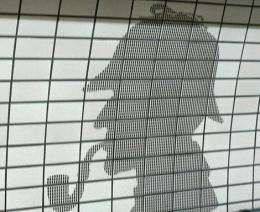Image: Sherlock's shadow at Baker Street tube station. Credit: Chris McKenna.
(PhysOrg.com) -- In the movie Sherlock Holmes: A Game of Shadows the sleuth’s arch-enemy has a new weapon: mathematics supplied by a team from Oxford University.
Alain Goriely and Derek Molton at Oxford’s Mathematical Institute were initially asked by the film’s creators to come up with 19th Century equations to fill Moriarty’s blackboard for one scene.
"Although they were quite secretive about the story, they told us that Moriarty was a mathematics professor and that they wanted us to help them add more meat to the script," Alain told New Scientist’s Jessica Hamzelou.
In the end, as the article reports, they ended up going on to invent a secret code that Moriarty uses in the film to send messages aimed at tipping Europe into war.
They based the code on hints by Arthur Conan Doyle that Moriarty wrote books on binomial theorem and asteroids: "Binomial theorem is linked to Pascal’s triangle, so we devised a secret code based on that," Alain comments to Jessica.
Numbers hidden in Moriarty’s notebook tell the reader which Fibonacci p-code - a way to take digits from Pacscal's triangle - to use. This gives a set of numbers which indicate the page, line, and words you need to look up to crack the code.
Moriarty’s interest in celestial objects is reflected in a lecture Alain and Derek wrote for the character to deliver in the film: it covers the n-body problem – the maths of how objects interact with each other as a result of gravitational forces.
"If you could build a missile and throw it out of the atmosphere, it could re-enter with an asteroid-like impact. It would be brought back by gravitational forces," Alain explains.
So does Oxford maths help the villainous Moriarty win out or does Holmes use his deductive powers to close the case? You’ll need to watch the film to find out.
Provided by Oxford University























